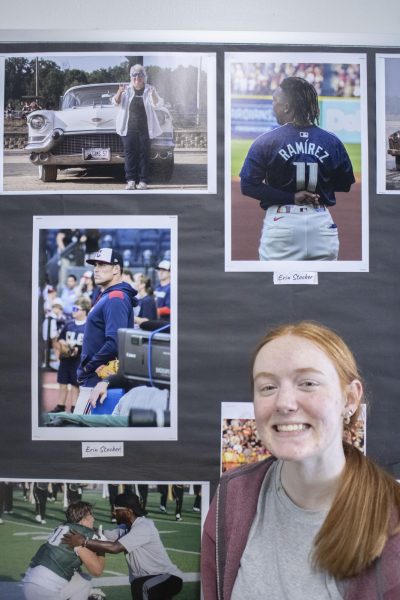Class rank dismissed for class of 2026
GlenOak administration gets rid of class rank and the Top 25 recognitions for class of 2026 and below.
The 0.06%: The top 25 of the class of 2021 stands to be recognized at graduation. In a class averaging 450 students these 25 represented 0.06%.
Many of you may have sat and pondered the questions: should I take full IB or a career tech? Is it worth it to stay in band, newstaff, dance or art at the risk of my GPA? How will this decision impact my class rank? Am I losing out on the Top 25 and does class rank really matter?
These questions go through the minds of many GlenOak High School students as they schedule classes each year. However, these questions are about to end. Top 25 and the class rank system will be replaced with a Cum Laude system starting with the freshmen class.
This new student recognition process will first be put to work for the class of 2026. By removing the Top 25, omitting class rank, and putting systems in place to recognize more high-achieving students, academics at GlenOak will look different for the freshman class and beyond.
“We are really excited to expand our opportunity to recognize more students and academic excellence,” head principal Gayle Kimbrough said
GlenOak High School will now utilize the Latin recognition system used in many colleges. The school hopes this will encourage students to explore other classes and electives offered at the high school that are not weighted classes but classes students are interested in and have a passion for.
They also would like to see students stop diluting their schedules with several study halls. This is something colleges frown upon. Students were doing this because study halls were not weighted. GPAs and class rank would go up if they took a study hall vs. an unweighted class.
The current system only recognizes the top 25 students. Many avoid or give up on electives they are passionate about, which are weighted on a 4.0 scale in favor of high-weighted 5.0 classes.
“Number one could get a 4.65, even if you go all the way down to number 50 in the class you’re still at a 4.29 and they’re not even close to getting a massive type of recognition,” counselor Kristen Zurbuch said.
The new system is broken up into three categories. Summa Cum Laude recognizes 4.4 and higher GPAs, Magna Cum Laude recognizes 4.1 to 4.39 and Cum Laude recognizes 3.9 to 4.0.
The overall goal is to recognize all students who achieved a high GPA no matter what the program they took was and to take off the mental stress that came with taking demanding classes.
“What I have observed as a counselor here for so many years is that kids are sacrificing their mental health and physical health trying to achieve that extra hundredth of a GPA point,” Zurbuch said.
The freshman class heard about Top 25 and the effects it has had on other students during an assembly on Thursday when they found out about the change.
“I feel like it [Top 25] was going to be more competitive and people would be let down if they didn’t make it,” freshman Allison Monroe said.
Many upperclassmen such as seniors or juniors have made many choices impacting their schedule revolving around Top 25.
“It really affected my choices on classes, the reach for the high GPA,” junior Taylor Herberghs said. “If that wasn’t a factor I may have explored career techs more.”
English teacher Anglea Beshore has noticed a significant amount of pressure put on her students.
“I have a lot of high-achieving students, and I see their stress levels,” Beshore said. “High school is supposed to be fun, and your GPA is important but your mental health is also.”
Some students are upset by the new decisions. They feel as though it eliminates the value of the awards and dedication to their grades.
“We might as well give everyone a participation trophy,” freshman Josh Jacob said. “I wish they would let people know that in the future it [Top 25] doesn’t matter as much.”
The message of Top 25 has been misinterpreted over the years. People strive to achieve this award because it could help them in college. However according to Zurbach, colleges look at well rounded students that partake in other electives. GPA or class rank does not guarantee a student into college.
Alumnus Jonah Nieschwitz lost his coveted number one spot when he decided to stay in news staff his senior year as editor-in-chief.
“I remember after I barely lost out for valedictorian I pushed for editor in chief to be weighted at a 5.0 because of the amount of work we did,” Nieschwitz said. “I’m not sure if they (colleges) would find much of a difference nowadays between number one and a person who is well rounded with a lot of different type of work. I can count on the amount of times (Top 25) has come up in college on one hand. It’s not super relevant beyond an ice breaker.”
Many students their junior and senior year play the GPA game. This is a known process where students select specific classes to boost their GPA’s. This requires eliminating arts and other non-weighted electives.
Band director Christopher Irwin feels this change will have a positive effect on the school and students.
“I’ve had a general feeling that the Top 25 has guided course choices over the years,” Irwin said.
The arts, electives and career techs are all courses offered at GlenOak to provide a deeper look into a possible career.
“Taking away the Top 25 as a guiding principle for course choices, may let students actually choose the course that they really want to take and have an interest in,” Iwrin said.
“I think it is really going to have a positive influence.”
The stories we have written on Top 25
Your donation will support the student journalists of GlenOak High School. Your contribution will allow us to purchase equipment and cover our annual website hosting costs.

Lucy is a senior at GlenOak. This is her 3rd year on staff. She is an OSMA student board member. She competes as a baton twirler and is involved in Speech...

Rachel Gortney is a senior, she has been on staff for three years. She is also the speech and debate team President, involved in OMUN, and Academic Challenge...






